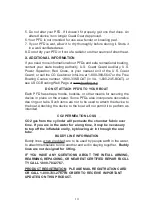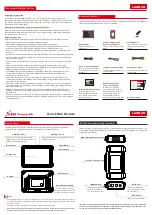
7
G. OTHER USE GUIDELINES
1. Always wear your PFD when underway unless you are inside a cabin.
2. If you need to jump from any height always fold arms over your chest
to keep the PFD in place when entering the water.
3. Avoid all unnecessary activities that will be abrasive to the device.
4. Use extreme caution around sharp objects.
5. Avoid unnecessary exposure to the sunlight. See GENERAL PRODUCT
LIFE EXPECTANCE below.
6. Inflatable PFDs are not designed for activities in which the wearer
expects to encounter impact with the water at a high-speed such as
water skiing, riding personal water-craft; etc.
7. Never use in below
freezing temperatures
unless worn partly inflated.
At or below 40°F inflation time with CO
2
gas will be longer. Wearing a
partially inflated PFD under these conditions will provide some initial
buoyancy while the PFD fully inflates.
8. CO2 gas from the cylinder will permeate through the chamber fabric
over time. If you are in the water for a long time, it may be necessary
to top off the inflatable orally, by blowing air in through the oral tube.
III. CARE AND MAINTENANCE INSTRUCTIONS
A. GENERAL PRODUCT LIFE EXPECTANCY
The reliability and service life of this PFD depends greatly upon how it is
used and cared for. Avoid storing PFD in direct sunlight. Sunlight con-
tains ultraviolet radiation that weakens synthetic materials. Prolonged
exposures to high temperatures and high humidity may shorten service
life of this PFD. While it is known that these elements degrade the mate-
rials, every use environment is unique so there is no sure way to esti-
mate how long the PFD will last. It is for this reason that you must follow
the Care and Cleaning Instructions and perform the maintenance and
service checks. This will assure that the PFD remains functional and will
maximize the useful life of this PFD. Failure to follow these instructions
rigorously could result in a non-functioning PFD causing
injury or death
.
B. CARE AND CLEANING INSTRUCTIONS
Drying
- If the device is wet, place on a coat hanger to allow thorough
drying. Do not place in direct sunlight to dry. Do not use any heat source
or place on radiator.


































